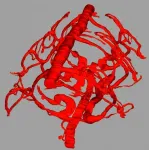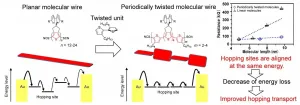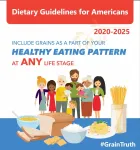A single gene 'invented' haemoglobin several times
2021-01-02
(Press-News.org) Thanks to the marine worm Platynereis dumerilii, an animal whose genes have evolved very slowly, scientists from CNRS, Université de Paris and Sorbonne Université, in association with others at the University of Saint Petersburg and the University of Rio de Janeiro, have shown that while haemoglobin appeared independently in several species, it actually descends from a single gene transmitted to all by their last common ancestor. These findings were published on 29 December 2020 in BMC Evolutionary Biology.
Having red blood is not peculiar to humans or mammals. This colour comes from haemoglobin, a complex protein specialized in transporting the oxygen found in the circulatory system of vertebrates, but also in annelids (a worm family whose most famous members are earthworms), molluscs (especially pond snails) and crustaceans (such as daphnia or 'water fleas'). It was thought that for haemoglobin to have appeared in such diverse species, it must have been 'invented' several times during evolution. But recent research has shown that all of these haemoglobins born 'independently' actually derive from a single ancestral gene.
Researchers from the Institut Jacques Monod (CNRS/Université de Paris), the Laboratoire Matière et Systèmes Complexes (CNRS/Université de Paris), the Station Biologique de Roscoff (CNRS/Sorbonne Université), the Universities of Saint Petersburg (Russia) and Rio de Janeiro (Brazil), conducted this research on Platynereis dumerilii, a small marine worm with red blood.
It is considered to be an animal that evolved slowly, because its genetic characteristics are close to those of the marine ancestor of most animals, Urbilateria(1). Studying these worms by comparing them with other species with red blood has helped in tracing back to the origins of haemoglobins.
The research focused on the broad family to which haemoglobins belong: globins, proteins present in almost all living beings that 'store' gases like oxygen and nitric oxide. But globins usually act inside the cells because they do not circulate in the blood like haemoglobin.
This work shows that in all species with red blood, it is the same gene that makes a globin called 'cytoglobin' that independently evolved to become a haemoglobin-encoding gene. This new circulating molecule made oxygen transport more efficient in their ancestors, who became larger and more active.
Scientists now want to change scale and continue this work by studying when and how the different specialized cells of bilaterian vascular systems emerged.
(1)Urbilateria is the last common ancestor of bilaterians, i.e. animals with bilateral (left-right) symmetry and complex organs, apart from species with simpler organization such as sponges and jellyfish.
INFORMATION:
[Attachments] See images for this press release:

ELSE PRESS RELEASES FROM THIS DATE:
2021-01-02
Osaka, Japan - Researchers at Osaka University synthesized twisted molecular wires just one molecule thick that can conduct electricity with less resistance compared with previous devices. This work may lead to carbon-based electronic devices that require fewer toxic materials or harsh processing methods.
Organic conductors, which are carbon-based materials that can conduct electricity, are an exciting new technology. Compared with conventional silicon electronics, organic conductors can be synthesized more easily, and can even be made into molecular wires. However, these structures suffer from reduced electrical conductivity, which prevents ...
2021-01-02
After "COVID-19," the term that most people will remember best from 2020 is likely to be "social distancing." While it most commonly applied to social gatherings with family and friends, it has impacted the way many receive medical care. Historically, the United States has been relatively slow to broadly adopt telemedicine, largely emphasizing in-person visits.
However, the COVID-19 pandemic, especially in the spring of 2020, necessitated increased use of virtual or phone call visits, even prompting the Center for Medicare and Medicaid Services (CMS) to relax some of its regulations, primarily for video-based ...
2021-01-02
N-Aryl-C-nitroazoles are an important class of heterocyclic compounds. They are used as pesticides and fungicides. However, these substances could be toxic to humans and cause mutations. As they are not frequently used, there is little data about them in the medicinal chemistry literature. However, it has been suggested recently that the groups of compounds that are traditionally avoided can help to fight pathogenic bacteria. Yet, to reduce toxic effects, a great amount of work must be carried out at the molecular level, ...
2021-01-02
The flag leaf is the last to emerge, indicating the transition from crop growth to grain production. Photosynthesis in this leaf provides the majority of the carbohydrates needed for grain filling--so it is the most important leaf for yield potential. A team from the University of Illinois and the International Rice Research Institute (IRRI) found that some flag leaves of different varieties of rice transform light and carbon dioxide into carbohydrates better than others. This finding could potentially open new opportunities for breeding higher yielding rice varieties.
Published ...
2021-01-02
In a study that looked at suicide deaths during 2020's first wave of the COVID-19 pandemic in Maryland, Johns Hopkins Medicine researchers found that, contrary to general predictions of suicides skyrocketing, suicides in the overall population actually dropped, relative to previous years. However, the researchers also discovered that suicide deaths increased dramatically among Black Marylanders during the same period.
The researchers say that their findings, published Dec. 16, 2020, in JAMA Psychiatry, highlight the importance of timely identification of high-risk groups and vulnerable populations to reduce suicide numbers.
Black Americans have been ...
2021-01-02
LOS ANGELES -- Scientists from the UCLA Jonsson Comprehensive Cancer Center have developed a simple, high-throughput method for transferring isolated mitochondria and their associated mitochondrial DNA into mammalian cells. This approach enables researchers to tailor a key genetic component of cells, to study and potentially treat debilitating diseases such as cancer, diabetes and metabolic disorders.
A study, published today in the journal Cell Reports, describes how the new UCLA-developed device, called MitoPunch, transfers mitochondria into 100,000 or more recipient cells simultaneously, which is a significant improvement from existing mitochondrial transfer technologies. The device is ...
2021-01-02
AURORA, Colo. (Dec. 29, 2020) - College football players may underestimate their risk of injury and concussion, according to a new study published today in JAMA Network Open.
Christine Baugh, PhD, MPH, assistant professor of medicine at the University of Colorado School of Medicine and member of the CU Center for Bioethics and Humanities, is the corresponding author of the article, "Accuracy of US College Football Players' Estimates of Their Risk of Concussion or Injury."
Baugh and co-authors report on survey results of 296 college football players from four teams in the Power 5 Conferences of ...
2021-01-02
People have puzzled for years why pathogen Phytophthora infestens causes the devastating late blight disease, source of the Irish Potato famine, on potatoes, but has no effect at all on plants like apple or cucumber. How are apple trees and cucumber plants able to completely shake off this devastating pathogen? Agricultural scientists have wondered for years: if this resistance is so complete and persists over so many generations, is there some way we could transfer it to susceptible plants like wheat and thereby stop disease?
Why is it so important to determine the molecular basis of nonhost resistance? ...
2021-01-02
Toronto - With the arrival of effective vaccines for the COVID-19 virus, the end of the pandemic is on the horizon but in the short term the virus continues to spread.
A timely new study published today by PLOS ONE examines the effectiveness of COVID-19 control policies in 40 jurisdictions including countries and U.S. states.
Among the conclusions is that significant social costs must be incurred to reduce the growth of the virus below zero. In most jurisdictions examined, policies with a lesser social impact including cancellation of public events, restrictions of gatherings ...
2021-01-02
The Grain Chain, a farm to fork coalition of stakeholders in the grain industry sector and chaired by the American Bakers Association (ABA), celebrates the recommendation published today in the 2020-2025 Dietary Guidelines for Americans (DGAs) to "consume half of your grains from whole grain sources" and the remainder from enriched grains. A foundational piece of the DGAs, the guidelines recognize whole grains are "one of the three food groups that are fundamental constituents of a healthy dietary pattern."
The United States Department of Agriculture (USDA) and Health and Human Services (HHS) oversee and publish the Dietary Guidelines, ...
LAST 30 PRESS RELEASES:
[Press-News.org] A single gene 'invented' haemoglobin several times




